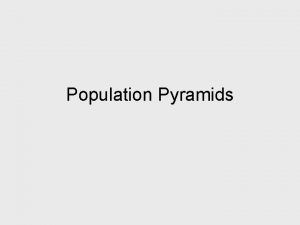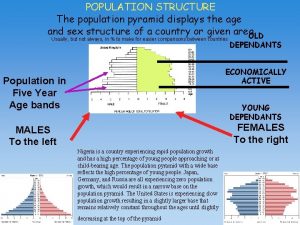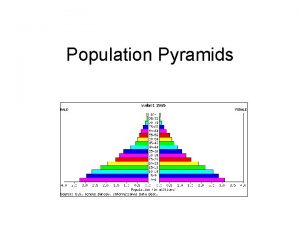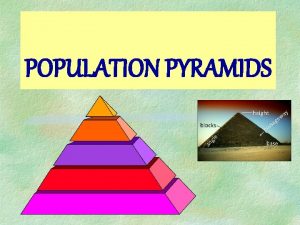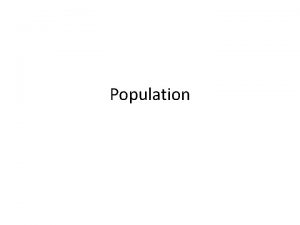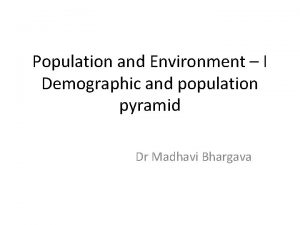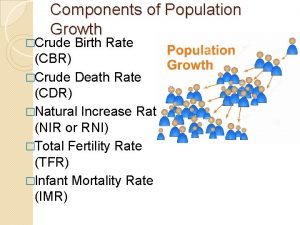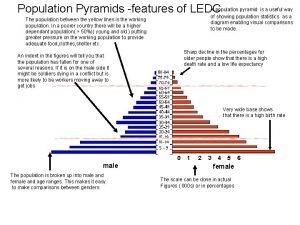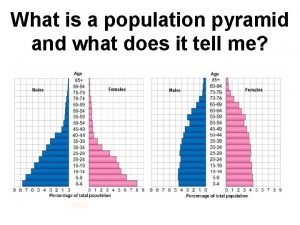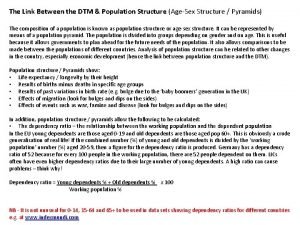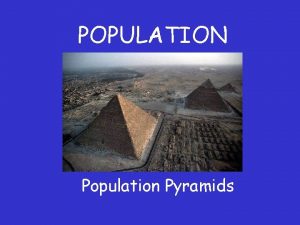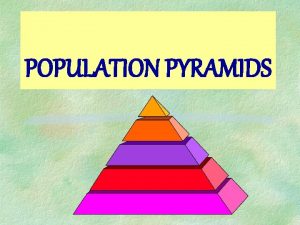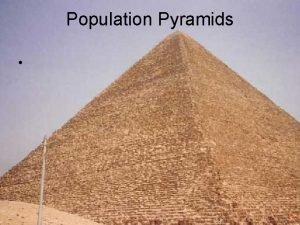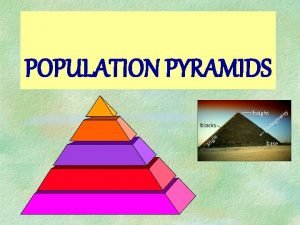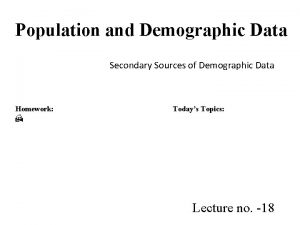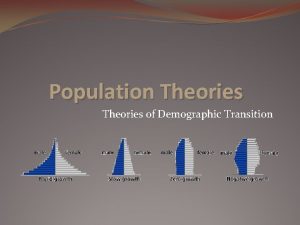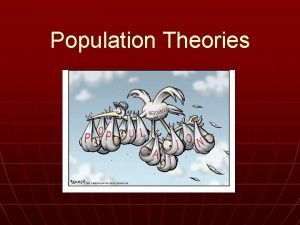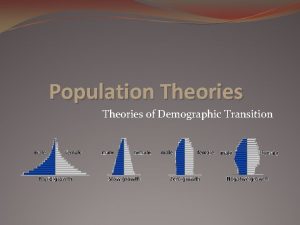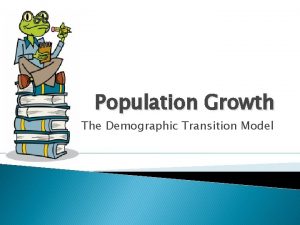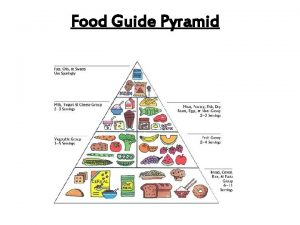Population and Environment I Demographic and population pyramid





























- Slides: 29

Population and Environment – I Demographic and population pyramid Dr Madhavi Bhargava


Maximum carrying capacity

Environmental components for carrying capacity a. Productive systems: farmland, orchards, etc that provide food b. Protective systems: climate, forest, oceans c. Waste assimilative system: rivers, wetlands that assimilate the human waste First two are: life-supportive capacity Last is: waste-assimilative capacity

Population doubling time and population pressure • Time required for a population to double itself • The population pressure is due to: 1. Dramatic increase in population 2. High densities in different parts of the world This gives rise to disparity in resource availability 15% of the population controls resources of 85% of world’s population

• It takes 15 -20 times as much resources to raise a child in US as compared to developing nations

• Differential growth rates in different countries • Impact of growth depends not just on rate of growth • Also depends on size and age structure of the population THE DEMOGRAPHY

Demography • Scientific study of human population • ‘Demos’ means people • Includes three important human phenomena: 1) Changes in population size 2) Composition of population 3) Distribution of population in space

Demographic processes Five important demographic processes: 1) Fertility 2) Mortality 3) Marriage 4) Migration 5) Social mobility These determine size, composition and distribution

Demographic cycle Mainly 5 stages: 1) 1 st stage: High stationary 2) 2 nd stage: Early expanding 3) 3 rd stage: Late expanding 4) 4 th stage: Low stationary 5) 5 th stage: Declining

First stage: High stationary • High birth rate • High death rate • These cancel each other and population remains stationary • India was in this stage till 1920

Second stage: Early expanding • • • Death rate declines Birth rate remains unchanged Better health and living conditions Shortened breast feeding duration Eg: Africa

Third stage: Late expanding • • • Death rate further declines Birth rate falls to some extent But birth rate > death rate India is in this phase Similarly China

Fourth stage: Low stationary • Low birth rate • Low death rate • Good health services and better standard of living • Results in ZERO population growth • Eg: UK, Denmark, Sweden • Mostly the developed and industrialized countries

Fifth stage: Declining • Birth rate is lower than the death rate • Example: Germany, Hungary Reasons for decline in fertility: 1)Education 2)Availability of contraception 3)Change in marriage and child birth patter 4)Growth and development 5)Governmental initiatives


Birth rate and Death rate Growth rate: Crude birth rate – Crude death rate

Population pyramid • Also known as age pyramid • Pictorial presentation of proportion of males and females in each age group • Age groups divided in groups of 5 -year interval • Youngest at the bottom • Oldest on the top Dependents • 15 to 65 years: the working population

What is a population pyramid Vertical Axis - Age Groups Elderly dependents Working population Young dependents Horizontal Axis – Percentage / number

Types of population pyramid • Triangular shape • Beehive shaped • Rectangular shaped

Broad-based Pyramid India in 2000 Shape: Broad Base - high birth rates Narrow Top - small elderly pop - high death rate Proportion: - Large proportion of young - high young dependency ratio Sex Ratio: Balance pyramid - Balance sex ratio

Beehive-shaped Pyramid

Beehive-shaped Pyramid Country: Singapore, 2000 Shape: Beehive shaped Proportion: Large proportion of working population, 15 -59 yr old - large group of economically active pop Sex Ratio: Balanced pyramid

Hong Kong 2000 Taiwan 2000


Population Pyramids in Transition

Dependency ration • Children below 15 and persons above 65 are considered dependent • Dependency ratio: Old age and young age dependency ratio can also be calculated seperately

Family size • Common language: Number of members in a family • In demography: Total number of children a woman has borne at a point of time • Completed family size: total children during reproductive age group • Family size depends on many factors

Factors affecting family size • • Age at marriage Duration of marriage Level of education Economic status Prevailing social and cultural practices Desired family size Use of family planning techniques
 The country with the narrowest population pyramid is
The country with the narrowest population pyramid is Population pyramid stage 1
Population pyramid stage 1 Financial environment in business environment
Financial environment in business environment Demographic and geographic characteristics
Demographic and geographic characteristics Demographic psychographic and geographic
Demographic psychographic and geographic The trends shaping human resource management
The trends shaping human resource management Rectangle population pyramid
Rectangle population pyramid Japan population pyramid
Japan population pyramid Broad based pyramid
Broad based pyramid Types of population pyramids
Types of population pyramids Population pyramid stages
Population pyramid stages Unalaska ak population pyramid
Unalaska ak population pyramid Population pyramid shapes
Population pyramid shapes Crude birth rate calculator
Crude birth rate calculator Expansive population pyramid
Expansive population pyramid Population of western europe
Population of western europe Population pyramid anomalies
Population pyramid anomalies Population pyramids
Population pyramids Ledc population pyramid
Ledc population pyramid Dubai population pyramid
Dubai population pyramid Dtm pyramid
Dtm pyramid Convex population pyramid
Convex population pyramid Russia depopulation
Russia depopulation Broad based pyramid
Broad based pyramid Newly industrialized country population pyramid
Newly industrialized country population pyramid Beehive shaped pyramid
Beehive shaped pyramid Newly industrialized population pyramid
Newly industrialized population pyramid Chapter 4 section 1 population dynamics
Chapter 4 section 1 population dynamics Section 1 population dynamics
Section 1 population dynamics Population ecology section 1 population dynamics
Population ecology section 1 population dynamics
